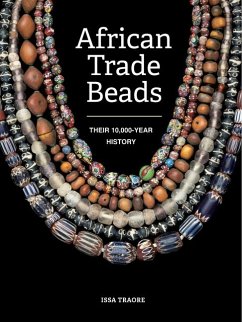First made and worn 120,000 years ago, beads were originally made of natural materials -- stones, shells, wood -- and have been used for adornment, currency and burial offerings. Trade beads of polished stones and shells have a history thousands of years old, but the first glass beads were made in Egypt. They were meant to be cheaper mimics of precious stones. A thriving glass bead manufacturing industry began in Murano (Venice) in 1291, and the trade spread to Holland, Bohemia and Moravia (Czech) and Germany, and traders brought them to Africa to trade for gold, ivory and spices. To this day, glass beads are prized in West Africa, and the antique beads shown in this book were once very common but are now quite scarce and coveted by collectors around the world. This beautiful book documents early-style beads made of cowrie shells, semi-precious stones and clay, and then shows in splendid detail hundreds of beads made of glass and other human-made materials that have been made by Europeans and Africans and traded for the last 600 years in Central and East Africa. Each is identified as to its origin and manufacture and approximate date. Covering shells, "Konon" (glass beads) and some contemporary beads, African Trade Beads' heart is "Konon" or Venetian trade beads that used to be easily found in his home country but are now scarce. Each is from the author's own collection and was obtained from rural Mali -- but they originated in many African countries and hundreds of years of trade brought them in wide ranges and mixtures, instead of their original uniformity.








